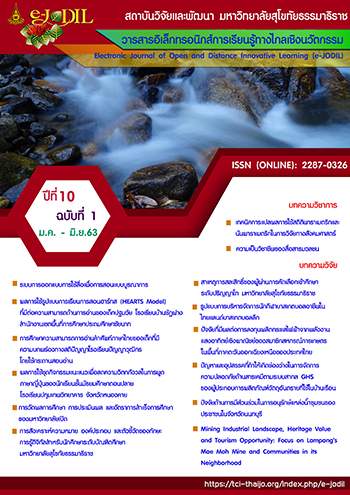Mining Industrial Landscape, Heritage Value and Tourism Opportunity: Focus on Lampang’s Mae Moh Mine and Communities in its Neighborhood
Main Article Content
บทคัดย่อ
This study investigates potential of reuse of the mining heritage in Mae Moh Mine, Lampang Province for tourism and recreation purpose. The study surveyed built and cultural heritage of mining, assessed its values, and utilized in-depth interview and focus group discussions with key informant groups. Mining heritage could be viewed as new to Thailand and seems contradictory in the feeling when proposing it with tourism. Nevertheless, international example practices of reuses and transformation of former mines and factories could settle some initial ideas for Thailand, in particular for the case of Lampang Mae Moh Mine. The study pointed out significance of alternative approach for the tourism industry of Lampang, while conservation of the industrial heritage should also be taken into account due to the fact that this type of heritage is at risk of disappearing. Finally, this study suggested potential approach for future consideration
Downloads
Article Details
บทความ ข้อความ ภาพประกอบ ตารางประกอบ ที่ตีพิมพ์ในวารสารเป็นความคิดเห็นและความรับผิดชอบของผู้เขียนแต่เพียงผู้เดียว ไม่เกี่ยวข้องกับมหาวิทยาลัยสุโขทัยธรรมาธิราชแต่อย่างใด
บทความที่เสนอพิจารณาในวารสาร e-JODIL ต้องเป็นบทความที่ไม่เคยส่งไปลงพิมพ์ เผยแพร่ หรืออยู่ระหว่างการพิจารณาของวารสารอื่น
กองบรรณาธิการขอสงวนสิทธิ์ในการพิจารณาและตัดสินการตีพิมพ์บทความในวารสาร
เอกสารอ้างอิง
(2) Amano, I. (2016). In praise of iron grandeur: the sensibility of kōjō moe and the reinvention of urban technoscape. DE GRUYTER Contemporary Japan, vol. 28, no. 2, p. 145-164. doi:10.1515/cj-2016-0008
(3) Australia ICOMOS International Council on Monuments and Sites. (2013). The Burra Charter- the Australia ICOMOS Charter for Places of Cultural Significance. Retrieved from https://australia.icomos.org/wp-content/uploads/The-Burra-Charter-2013-Adopted-31.10.2013.pdf
(4) Berger, S. and Golombek, J. (2018). Industrial heritage and regional identities. Routledge.
(5) Boros, L., Martin, Z., and Pal, V. (2013). Industrial tourism- trends and opportunities. Forum geographic, vol.12, no. 1, p. 108-114.
(6) Cole, D. (2004). Exploring the sustainability of mining heritage tourism, cited in Frew, E. (2011). Transforming working mines into tourist attractions. In V. Conlin, M. and Jolliffe, L. (Eds.). Mining Heritage and Tourism. Routledge.
(7) Dekker, R. (n.d.). 798 Art Zone Beijing: Site of ‘Cultural Revolution’ or Showpiece of City Marketing?. Master Dissertation. Retrieved from https://lib.ugent.be/fulltxt/RUG01/001/790/567/RUG01-001790567_2012_0001_AC.pdf
(8) Department of Mineral Resources. แหล่งเรียนรู้ทางธรณีวิทยาจังหวัดลําปาง. [Learning source of Lampang geology]. Retrieved from http://www.dmr.go.th/download/article/article_20110209141537.pdf
(9) Department of Primary Industries and Mines. Minerals Act, B.E. 2560 (2017). Retrieved from http://www.dpim.go.th/en/media/002_2560.pdf
(10) Douet, J. (Eds.). (2012). Industrial Heritage Re-tooled: The TICCH Guide to Industrial Heritage Conservation. Latitude Press.
(11) Hsiung Tsai, T. (n.d.). The relationship between the development of industrial heritage tourism and communities; the upcoming 10th Anniversary of the Gold Museum, New Taipei City Government. Retrieved from https://www.gep.ntpc.gov.tw/files/file_pool/1/0G252592144420468044/01_20140128_E.pdf
(12) Hui Liu, Z. and Jaan Lee, Y. (2015). A method for development of ecomuseums in Taiwan. Sustainability, vol. 7, p. 13249-13269. doi: 10.3390/su71013249. Retrieved from https://www.researchgate.net/publication/282287320_A_Method_for_Development_of_Ecomuseums_in_Taiwan
(13) ICOMOS. The Nizhny Tagil Charter for the Industrial Heritage. (2003). Retrieved from https://www.icomos.org/18thapril/2006/nizhny-tagil-charter-e.pdf
(14) Palmer, M. and Neaverson, P. (1998). Industrial Archaeology- Principles and Practice. Oxon: Routledge.
(15) Satherley, S.D. (2005). Reconnection: a contemporary development in cultural landscape theory contributing to rehabilitation strategies for Australian open-cut coal mining landscapes. Retrieved from https://eprints.qut.edu.au/59556/6/59556a.pdf
(16) Sepulchre, P.et al. (2010). Mid-Tertiary paleo environments in Thailand: pollen evidence. Clim. Past, vol. 6, p. 461–473. doi:10.5194/cp-6-461-2010
(17) Swedish Ministry of Enterprise, Energy and Communications. Sweden’s Minerals Strategy For sustainable use of Sweden’s mineral resources that creates growth throughout the country. Retrieved from https://www.government.se/49b757/contentassets/78bb6c6324bf43158d7c153ebf2a4611/swedens-
minerals-strategy.-for-sustainable-use-of-swedens-mineral-resources-that-creates-growth-throughout-the-country-part-1-of-2
(18) “The most beautiful coal mine in the world: the Zollverein UNESCO World Heritage Site Tourist development, products and highlights”. (January 21, 2018). Retrieved from https://worldheritagegermany.com/the-most-beautiful-coal-mine-in-the-world-the-zollverein-unesco-world-heritage-site-tourist-development-products-and-highlights/
(19) UNESCO World Heritage Convention. “Zollverein Coal Mine Industrial Complex in Essen” Retrieved from https://whc.unesco.org/en/list/975
(20) Wickanet Songtham (2005). Sedimentary facies and environments of an unusual thick shell bed in Mae Moh Basin, Lampang Province, Thailand, International Conference on Geology, Geotechnology and Mineral Resources of Indochina (GEOINDO 2005) 28-30 November 2005, Khon Kaen, Thailand. Retrieved from http://library.dmr.go.th/Document/Proceedings-Yearbooks/M_1/2005/9387.pdf


